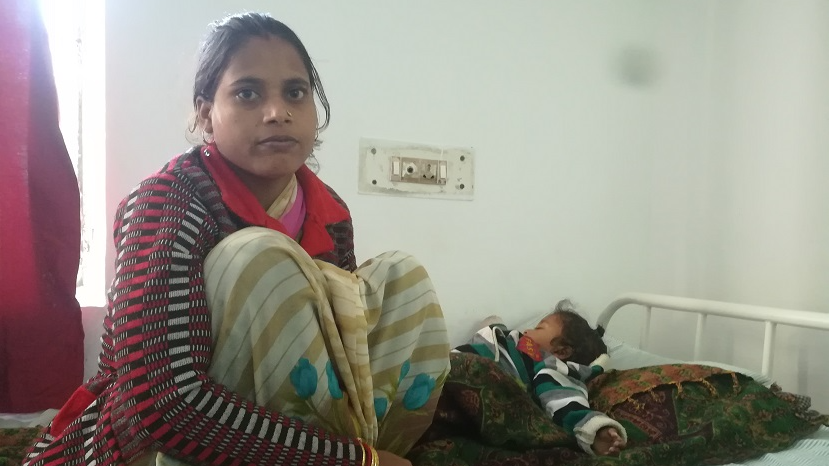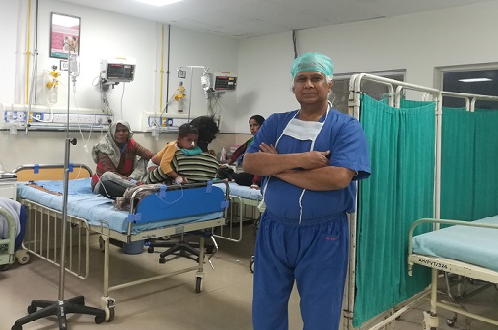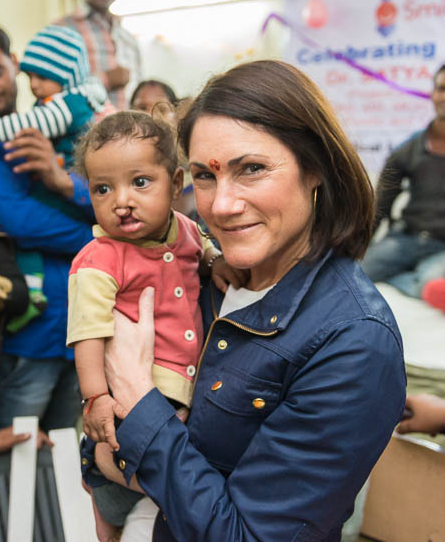
Godavari and her one-and-a-half year old son, Sourabh
In a small aluminum cubical, Godavari is sitting on the edge of the bed. Her one-and-a-half year old son, Sourabh, is sleeping next to her. She is worried that the screams of a child from the adjoining cubical might wake him up. Sourabh is recovering from the cleft lip surgery he underwent three days back.
While Sourabh is fast asleep, Godavari’s mind drifts to the day he was born. She gave birth at home under the supervision of a dai (midwife). She was shocked when she first saw her baby--he had a huge cut on his upper lip that extended to the base of his nose. She had never seen anything like that before.
Soon, much to her dismay, her family started blaming her. “They told me it was my fault, I must have done something wrong during my pregnancy. I and my husband cried for days. There was no one in our village who could tell us what’s wrong with our son,” she says, a thick drop of appearing on her eyelid.
Each day after the birth her child was a struggle for Godavari. She faced taunts for no fault of hers and taking care of Sourabh was tough, too. “He could not eat or drink anything. He would regurgitate almost everything I would try to feed him,” she says.
One day, a relative dropped in with a social worker from Smile Train, an NGO. Manoj Pradhan, the social worker, was carrying pictures of children who had similar cut on their lips. He also had pictures of these children after the surgery corrected the deformity. “They looked all well. So, I and my husband brought Saurabh to the camp they organized. And here we are. He underwent the surgery and doctors say he would be alright now,” she says smiling.
One in 700 children is born with cleft lip or palate in India, the severity may vary from a small hole or cut around the lip in some children to the total separation of the lip all the way up into the nose in others.
In a cleft palate, the roof of a child’s mouth has a gap. Some have a small gap but in severe cases a major cavity runs from the front to the back of the mouth.
Though every form of cleft deformity can be corrected, millions of children continue to live with the deformity due to lack of awareness and access to healthcare.
“Ideally, a cleft lip repair surgery should be done when child is three- months- old and a cleft palette surgery when he is six- months -old. But in India, most patients come late. Also by the time they come for surgery, it s quite late and we have to deal with the malnourishment too. It is difficult to feed a child with cleft,” says Mamta Carroll , regional director, South East Asia, Smile Train.
“However, a lot has changed in the last 17 years. Initially, we used to get a lot of adult patients and a few children. Now, thankfully most of our patients are children,” she says.
 Dr Vijai Shanker Singh does 70 cleft lip surgeries every month.
Dr Vijai Shanker Singh does 70 cleft lip surgeries every month.
Over 35,000 children undergo surgeries for cleft lip/ palate every year in India under the program run by Smile Train. “We do over 70 surgeries a month at our hospital. Some children need repeat surgeries if the deformity is severe,” says Dr Vijai Shanker Singh, senior consultant plastic surgeon, Anand hospital, Merrut, a partner hospital of Smile Train.
“Our social workers organise awareness camps in villages across UP, go door- to- door looking for children born with cleft and bring them to the hospital for surgeries,” he says.
Cleft deformities have social, economic and medical impact on the children as well as their families.
People blame their wives for a cleft deformity in the child and, in many cases, even abandon them. These children are not accepted by the society, they are often bullied by the children of their age. Most don’t have access to education and find it difficult to get a job when they grow up.
Besides, they are prone to frequent upper respiratory tract infections, depression and anxiety.
The exact cause for cleft deformities is not known, doctors feel that malnourishment in mothers, and infections in the early weeks of pregnancy could be a possible cause.
 Susannah Schaefer, CEO, Smile Train
Susannah Schaefer, CEO, Smile Train
The treatment is a plastic surgery, where a surgeon closes the gap. In some cases, a bone graft is used to reconstruct the affected nose. “The surgery is a complex and that’s why we train the surgeons involved in the project. We have a virtual surgery simulator to train surgeons across the world. We also maintain data about every child we treat, which helps us keep a track of the outcomes of the surgery,” says Susannah Schaefer, CEO, Smile Train.
After the cleft is repaired, these children often need a follow-up treatment for the crowding of teeth and speech impediment.
Aman Tyagi, 23 is from Bhooni, a small village near Shamli in UP. He had two surgeries for cleft palate when he was 5. But by then, he had developed speech and mispronounced many words as the cleft in the palate didn’t allow him to speak a few alphabets properly.
Tyagi could pursue studies because of the timely intervention. His speech impediment never allowed him to excel in career. Now he is undergoing speech therapy. “His speech has improved tremendously. A clear speech gives these children a new confidence,” says Sherlyn Kerketta, speech therapist.